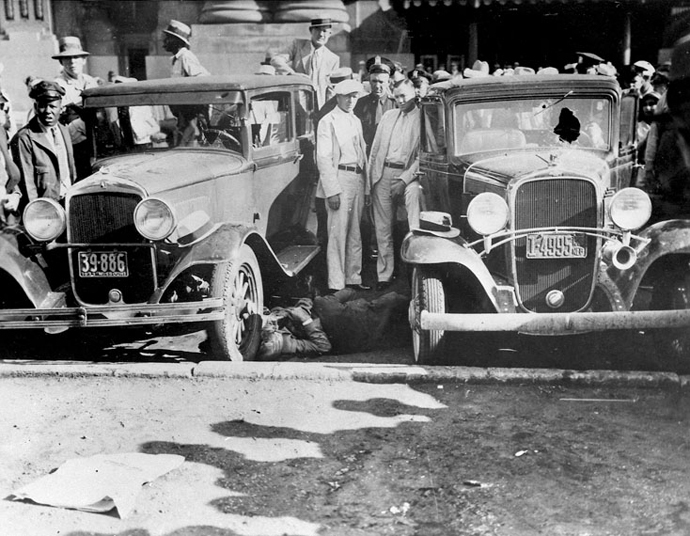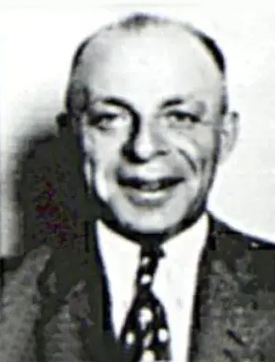
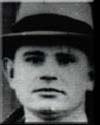
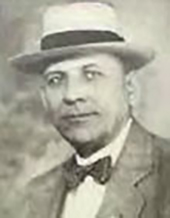
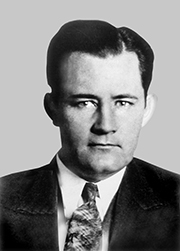
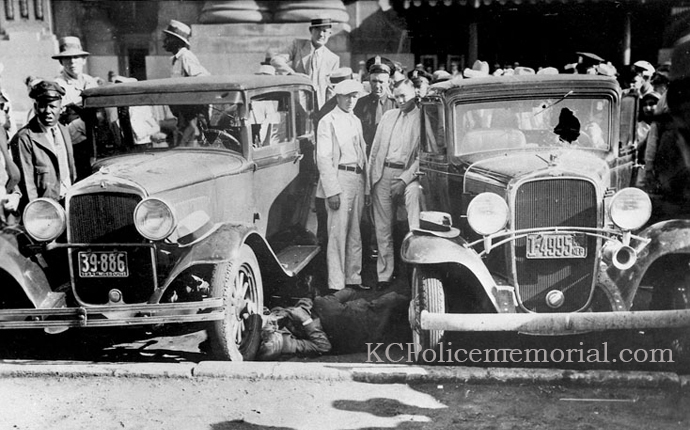
ADAM C. RICHETTI
On the morning of June 17, 1933, a mass murder committed in front of Union Railway Station, Kansas City, Missouri, shocked the American public into a new consciousness of the serious crime problems in the Nation. The killings which took the lives of four law enforcement officers and their prisoner, are most often remembered as The 'Union Station Massacre' also known as 'The Kansas City Massacre.'
The Union Station Massacre involved the attempt by Charles Arthur "Pretty Boy" Floyd, Vernon Miller and Adam Richetti to free Miller's close friend, Frank Nash, a Federal prisoner. At the time, Nash was in the custody of law enforcement officers returning him to the U.S. Penitentiary at Leavenworth, Kansas from which he escaped on October 19, 1930.
Nash's criminal record reached back to 1913, when he was sentenced to life at the State Penitentiary, McAlester, Oklahoma, for murder. He was later pardoned. In 1920, he was given a 25-year sentence at the same penitentiary for burglary with explosives, and later pardoned. On March 3, 1924, Nash began a 25-year sentence at the U.S. Penitentiary at Leavenworth for assaulting a mail custodian. He escaped on October 19, 1930.
The Federal Bureau of Investigation (FBI) launched an intensive search for Nash which extended over the entire United States and parts of Canada. Evidence gathered by the FBI indicated that Nash had assisted in the escape of seven prisoners from the U.S. Penitentiary at Leavenworth on December 11, 1931.
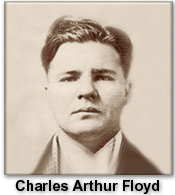
CHARLES ARTHUR "PRETTY BOY" FLOYD
The investigation also disclosed Nash's close association with Francis L. Keating, Thomas Holden and several other well-known gunmen who had participated in a number of bank robberies throughout the Midwest. Keating and Holden were apprehended by FBI Agents on July 7, 1932, at Kansas City, Missouri. Information gained by the FBI as a result of the apprehension of these two indicated that Nash was receiving protection from his underworld contacts in Hot Springs, Arkansas.
Based on such information, two FBI Agents, Frank Smith and F. Joseph Lackey, and McAlester, Oklahoma, Police Chief Orin 'Otto' Reed located and apprehended Nash on June 16, 1933, in a store in Hot Springs, Arkansas. The law officers drove Nash to Fort Smith, Arkansas, where at 8:30 that night, they boarded a Missouri Pacific train bound for Kansas City, Missouri.
Meanwhile, a number of outlaw friends of Nash had heard of his capture in Hot Springs. They learned the time of the scheduled arrival of Nash and his captors in Kansas City and made plans to free him. The scheme was conceived and engineered by Richard Tallman Galatas, Herbert Farmer, "Doc" Louis Stacci, Frank B. Mulloy and Vernon Miller, who was designated to free Nash.
On their way to Kansas City, Floyd and Richetti had been detained at Bolivar, Missouri, early on the morning of the 16th, when the car in which they were riding became disabled. While the two were waiting in a local garage for the necessary repairs to the car, Sheriff Jack Killingsworth entered the building. Richetti, who immediately recognized the Sheriff, seized a machine gun and held the Sheriff and the garage attendants against the wall. Floyd drew two .45 caliber automatic pistols and ordered all parties to remain motionless. Floyd and Richetti then transferred their arsenal into another automobile and ordered the Sheriff into that vehicle. The two, along with their prisoner, then drove to Deepwater, Missouri, abandoned that automobile and commandeered another. After releasing the Sheriff, they arrived in Kansas City about 10:00 p.m. on June 16. There Floyd and Richetti abandoned that automobile and stole another car to which they transferred their baggage and firearms. Finally, that same night, they met Miller and went with him to his home. There Miller told them of his plan to free Frank Nash. Floyd and Richetti agreed to help in the endeavor. Early the next morning, Miller, Floyd and Richetti drove to the Union Railway Station in a Chevrolet sedan. There they took up their positions to await the arrival of Nash and his captors.
The train carrying Nash and the lawmen was due to arrive in Kansas City at 7:15 a.m. on June 17. Before leaving on the train, the lawmen made arrangements for Reed E. Vetterli, Special Agent in Charge of the FBI's Kansas City Office to meet them at the train station.
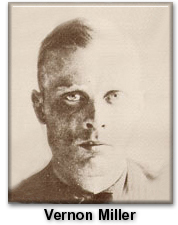
VERNON MILLER ADAM RICHETTI
Upon the arrival of the train in Kansas City, Agent Lackey went to the loading platform, leaving Smith, Reed and Nash in a stateroom of the train. On the platform, he was met by SAC Vetterli, who was accompanied by FBI Agent Raymond J. Caffrey and Detectives William. J. Grooms and Frank Hermanson of the Kansas City Police Department. These men surveyed the area surrounding the platform and saw nothing that aroused their suspicion. SAC Vetterli advised Agent Lackey that he and Caffrey had brought two cars to Union Station and that the cars were parked immediately outside.
Agent Lackey then returned to the train and accompanied by Chief Reed, Vetterli, Agents Vetterli, Caffrey and Smith, and Detectives Hermanson and Grooms--proceeded from the train through the lobby of Union Station. At the time, both Agent Lackey and Chief Reed were armed with shotguns and the other officers carried pistols.
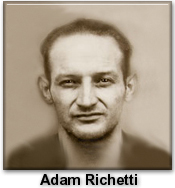
Upon leaving Union Station, the lawmen, with their captive, paused briefly; and, again seeing nothing that aroused their suspicion, they proceeded to Caffrey's Chevrolet. Frank Nash was handcuffed throughout the trip from the train to the Chevrolet, which was parked directly in front of the east entrance of Union Station.
Agent Caffrey unlocked the right door of the Chevrolet. Agent Lackey told Nash to get into the front seat of the car. Lackey then climbed into the back of the car directly behind the driver's seat. Agent Smith sat beside him in the center of the back; and Chief Reed sat beside Smith in the right rear seat.
At this point, Agent Caffrey walked around the car to get into the driver's seat through the left door. SAC Vetterli stood with Officers Hermanson and Grooms at the right side near the front of the car.
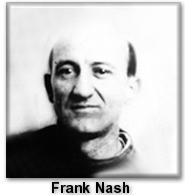
A green Plymouth was parked about six feet away on the right side of Agent Caffrey's car. Looking in the direction of this Plymouth, Agent Lackey saw two men run from behind a car. He noticed that both men were armed. At least one of them had a machine gun. Before Agent Lackey had a chance to warn his fellow officers, one of the gunmen shouted, "Up, up!" At this instant, Agent Smith--who was in the middle of the back seat -- also saw a man with a machine gun to the right of the Plymouth. SAC Vetterli, who was standing at the right front of the Chevrolet turned just in time to hear a voice command, "Let 'em have it!"
At this point, from a distance approximately 15 feet diagonally to the right of Agent Caffrey's Chevrolet, an individual crouched behind the radiator of another car opened fire. Detectives Grooms and Hermanson immediately fell to the ground, dead. SAC Vetterli--who was standing beside Detectives Grooms and Hermanson--was shot in the left arm and dropped to the ground. As he attempted to scramble to the left side of the car to join Agent Caffrey, who had not yet entered the driver's seat of the Chevrolet, SAC Vetterli saw Caffrey fall to the ground after sustaining a gun shot wound to the head.
Inside the car, Frank Nash and Chief Reed were killed by bullets from the hoodlums' guns. Agents Lackey and Smith were able to survive the massacre by falling forward in the back seat of the Chevrolet. Lackey was struck and seriously wounded by three bullets. Smith was unscathed.
The three gunmen rushed to the lawmen's car and looked inside. One of them was heard to shout "They're all dead. Let's get out of here." With that, they raced toward a dark-colored Chevrolet. Just then a Kansas City policeman emerged from Union Station and began firing in the direction of one of the killers, later identified as Floyd, who slumped briefly but continued to run. The killers entered the car which sped westward out of the parking area, and disappeared.
The three survivors--Agents Smith and Lackey and SAC Vetterli--reported that the assault lasted possibly 30 seconds. They were uncertain if three or four gunmen staged the assault. From their account, it was apparent that the two Kansas City Police Detectives were killed immediately, followed seconds later by Frank Nash and Chief Reed and then by Agent Caffrey, who was taken to nearby General Hospital where he was pronounced dead as a result of a skull fracture and a gunshot wound to the head.
The FBI immediately initiated an investigation to identify and apprehend the gunmen. The investigation developed evidence that the scheme was carried out by Vernon C. Miller, Adam C. Richetti, and Charles Arthur "Pretty Boy" Floyd. The evidence included latent fingerprint impressions located by FBI Agents on beer bottles in Miller's Kansas City home and identified as those of Adam Richetti, thus helping to link the latter to the crime.
Vernon C. Miller, age 37, who had led the killings at Kansas City's Union Station on June 17, grew up in South Dakota. He had enlisted in the U.S. Army during World War I and received extensive training as a machine gunner. Following his release from the Army, he appeared at Huron, South Dakota, where he told stories of his heroism in the war. He also demonstrated to city officials that he was a crack shot, following which he was elected to the position of policeman in 1920. Two years later, he was elected Sheriff and was renominated for the position. Before the election, however, he disappeared and entered a life of crime. Miller's criminal record indicated that he had been arrested on April 4, 1923, and received at the South Dakota Penitentiary in Sioux Falls, South Dakota, to serve a sentence of two to ten years and to pay a $5,200 fine for embezzling public funds. In October, 1925, he was indicted in Federal Court, Sioux Falls, South Dakota, for violating the National Prohibition Act; the case was nolle prossed in January, 1931. Miller then moved to St. Paul, Minnesota, and Chicago where he began his association with underworld gangs. Miller was reported to have been a hired gunman for Louis Buchalter early in his crime career.
Following the Kansas City Massacre, Miller, accompanied by a girlfriend, Vivian Mathias, traveled to Chicago and reportedly arrived there on or about June 19, 1933. For a few days, he hid out with a member of the Barker-Karpis gang. From there Miller reportedly went to New York.
On October 31, 1933, an FBI investigation disclosed that Miller was back in Chicago at the apartment of Vivian Mathias. The next day, he escaped a trap set for him there by the FBI. However, Mathias was taken into custody and later pleaded guilty to charges of harboring and concealing Miller.
On November 29, 1933, during the FBI's search for Miller, his mutilated body was found in a ditch on the outskirts of Detroit, Michigan. He had been beaten and strangled. Information received by the FBI indicated that Miller had been involved in an altercation with a henchman of Longie Zwillman, head of New Jersey's underworld mob, in Newark; during the argument, Miller had shot the henchman. Another of Zwillman's associates reportedly retaliated by killing Miller.
Meanwhile, the FBI's hunt for "Pretty Boy" Floyd and Adam Richetti continued. Charles Arthur "Pretty Boy" Floyd, about 29 years old at the time of the Kansas City Massacre, had been arrested on numerous occasions, the first by the St. Louis, Missouri, Police Department on September 16, 1925, for highway robbery. He pleaded guilty to that charge on December 8, 1925, was sentenced to the State Penitentiary at Jefferson City, Missouri, and released on March 7, 1929. Two days later, on March 9, 1929, he was arrested by the Kansas City Police Department for investigation, and on May 6, 1929, for vagrancy and suspicion of highway robbery. In both instances, he was released. On May 20, 1930, Floyd was arrested by the Toledo, Ohio, Police Department on a bank robbery charge and on November 24, 1930, was sentenced to 12 to 15 years in the Ohio State Penitentiary. Floyd escaped en-route to the penitentiary and was a fugitive when he became involved in the Kansas City Massacre.
Adam C. Richetti, about 23 years old at the time of the Kansas City Massacre, began his criminal career with an arrest in Hammond, Indiana, on August 7, 1928, for a holdup. Richetti was sentenced from one to ten years in the State Reformatory, Pendleton, Indiana, for that crime. He was paroled on October 2, 1930, and discharged from the parole on September 23, 1931. His next arrest occurred on March 9, 1932, at Sulphur, Oklahoma, for bank robbery; he subsequently served a sentence at the State Penitentiary, McAlester, Oklahoma, from April 5, 1932, to August 25, 1932, when he was released and placed on bond which he forfeited. Richetti subsequently was sought for jumping the $15,000 bond, and was wanted at Tishomingo, Oklahoma, for robbery.
After fleeing from the Kansas City Massacre, Floyd and Richetti made their way to Toledo, Ohio, where they met Beulah, also known as Juanita, and Rose Baird in early September, 1933. From there the four traveled to Buffalo, New York. On September 21, 1933, Floyd and Beulah Baird, using the names of Mr. and Mrs. George Sanders, and Richetti and Rose Baird, using the names Mr. and Mrs. Ed Brennan, rented an apartment in that city.
The other occupants of the apartment building considered the two couples very mysterious inasmuch as they seldom left the apartment, then usually for brief visits to the grocery store. During their occupancy, Floyd reportedly walked from the front to the rear of the apartment almost constantly, an activity that caused much curiosity on the part of the other building occupants. The two couples never visited with any of their neighbors, though they were friendly toward the neighborhood children who sometimes were permitted to enter the apartment. The women occasionally threw money from the windows of the apartment to the children playing in the street, or offered them candy.
In October, 1934, the couples agreed to return to Oklahoma. Rose Baird was given money to purchase a car, and she bought a Ford sedan which was to carry them west.
The four began the trip early on October 20, with Floyd driving. A few hours later, near Wellsville, Ohio, he skidded the automobile into a telephone pole. Floyd and Richetti removed their firearms from the vehicle and remained on the outskirts of the town, while Rose and Beulah Baird took the damaged car into a Wellsville garage for repairs.
The Wellsville, Ohio, Police Chief, J. H. Fultz, following up on reports that two suspicious-looking men were seen on the outskirts of town, found the two resting in a wood tract of land nearby. A gun battle ensued. Chief Fultz apprehended Richetti after Richetti had emptied his gun at the officer. Floyd escaped, but the Police Chief thought Floyd might have been wounded.
The FBI and local authorities conducted an intensive search for Floyd in eastern Ohio following the Wellsville incident. This included interviews of numerous persons in the predominantly rural countryside, including doctors and hospital personnel whom Floyd might approach if, in fact, he was wounded.
Eight of the participants in this search--a squad of four FBI Agents led by Melvin Purvis, along with a squad of four East Liverpool, Ohio, police officers headed by Chief of Police Hugh McDermott--were jointly patrolling a group of roads south of Clarkson, Ohio, in two cars on October 22, when they noticed an automobile move from behind a corn crib on a farm. The officers had been questioning all persons whom they saw; and in an effort to question the occupants of this automobile, they stopped their cars. At this point, the vehicle that had attracted their attention drove back to its original position behind the corn crib, and a man whom the officers immediately recognized as Floyd jumped from the car with a .45 caliber automatic pistol in his right hand.
As the officers reached Floyd, he said, "I'm done for; you've hit me twice." They took the pistol from his hand and also seized a second gun that he carried in his belt. Then two FBI Agents left to summon an ambulance to take Floyd to a hospital. They were accompanied by a local citizen who had witnessed the encounter. Two other local citizens, including the owner of the farm where the shooting took place, also were witnesses to the action that had occurred. Floyd died about 15 minutes after he was shot.
At the time Floyd was killed, a watch and fob, consisting of a "lucky piece," were found on his person. Groups of ten notches were found on each of these items - reportedly carved by Floyd as an indication of the number of people he had killed.
Rose and Beulah Baird, who were in the Wellsville garage attending to the repair of the wrecked automobile when they overheard the discussion of Richetti's being taken into custody, had left immediately for Kansas City, Missouri. Later they traveled to the home of Floyd's family in Sallisaw, Oklahoma, where they attended the funeral of Charles "Pretty Boy" Floyd.
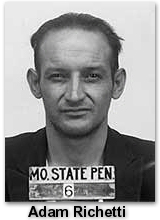
Adam Richetti, following his apprehension, was returned to Kansas City, Missouri, and on March 1, 1935, was indicted by the Jackson County Grand Jury on four counts of murder in the first degree. His trial, predicated on the indictment charging him with the murder of Frank E. Hermanson, one of the police Detectives killed in the Kansas City, Missouri, Massacre, began in Kansas City on June 10, 1935. On June 17, the jury returned a verdict of guilty with the recommendation that Richetti be given the death penalty. He was sentenced to be hanged. Richetti appealed his conviction, but it was affirmed by the Missouri Supreme Court on May 3, 1938. Subsequently, Richetti's lawyers alleged Richetti to be insane, and a hearing was held at which time his sanity was clearly established. On August 31, 1938, Richetti was again sentenced to death, this time in the gas chamber of the Missouri State Penitentiary of Jefferson City, Missouri. He was executed on October 7, 1938.
The four individuals - Richard Galatas, Herbert Farmer, "Doc" Louis Stacci, and Frank Mulloy - who the investigation disclosed had engineered the conspiracy to free Nash, were indicted by a Federal Grand Jury at Kansas City, Missouri, on October 24, 1934. On January 4, 1935, the four were found guilty of conspiracy to cause the escape of a Federal Prisoner from the custody of the United States. On the following day, each was sentenced to serve two years in a Federal Penitentiary and pay a fine of $10,000, the maximum penalty allowed by law.
Detective William J. Grooms, 29, (01-19-1904) was pronounced dead at Union Station as a result of a gunshot wound to the chest. He was survived by his wife, Myrtle. Interred: St. Mary's.
Detective Frank Hermanson, 42, (11-08-1890, Sweden) was pronounced dead at Union Station as a result of a gunshot wound to the head and skull fracture. He was survived by his wife, Montie. Interred: Woodlawn Cemetery - later moved to Highland Park Cemetery, KCKS.
Chief Orin Henry "Otto" Reed, 49, (03-13-1884) was pronounced dead at Union Station as a result of a gunshot wound to the head. He was survived by his wife Phoebe. Interred: Oak Hill Memorial Park, McAlester, Oklahoma.
Agent Raymond J. Caffrey, 31, (05-15-1902) was pronounced dead at General Hospital, Kansas City, Missouri as a result of a skull fracture and gunshot wound with a skull fracture. He was survived by his wife. Interred: Omaha, Nebraska.
Article by Brent Marchant
